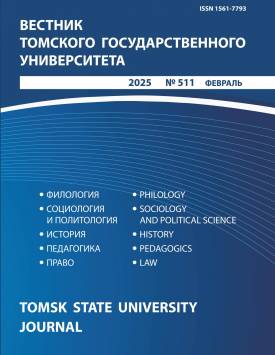Changing the electoral situation in the Russian Federation based on the adoption of the Constitution of the Russian Federation and amendments to it
The article discusses electoral behavior (support of the initiatives of the authorities and the appearance of voters) on a popular vote on the adoption of the Constitution of the Russian Federation and the all-Russian vote to amend it. A historical review of the introduction of the Basic Law of the country and the preceding documents in the Russian Empire, the USSR, and the Russian Federation is given. These electoral events are compared and analyzed with the involvement of the presidential elections in 1996 and 2018. In the territorial aspect, a change in the signaling sign of the support of the initiatives of the authorities and the appearance of voters is revealed. In this regard, the aim and objectives of the study were set. The aim of the study was to compare the results of the vote on the adoption of the Constitution of the Russian Federation in 1993 and the amendments to it in 2020 at the regional and macro-regional levels, and to identify regions where the sign of the correlation between voting "for" and voter turnout has changed. This comparison allowed us to identify trends in the change of electoral sentiments in the constituent entities of the Russian Federation regarding both the country's main law and the initiatives of the federal government. The source materials were the results of referendums, nationwide electoral events, and the presidential elections of 1996 and 2018. The study was based on spatial and correlation analysis of the corresponding statistical data. In carrying out the work, we used comparative-geographical, statistical, historical, and cartographic approaches and research methods. The cartographic research method allowed us to determine the areas of variation of electoral events, their integrity, and discontinuities. The information and theoretical basis of the study consisted of the works of domestic and foreign specialists in the field of economic and political geography. When analyzing the results of the votes on the adoption of the Constitution of the Russian Federation and the amendments to it, heterogeneities in electoral behavior were revealed at the macro-regional and regional levels. In the European part of the country, a direction of weakening support for government initiatives and the level of turnout from the southwest to the northeast was identified; the Asian part is similar to the northern and eastern regions of the European part of the country. The change in the sign of the correlation between voter turnout and voting "for" the ruling party between 2003 and 2020 occurred in most of the country. Regions that did not contribute to the change of sign are located in the Central Non-Black Earth and Northwestern macro-regions, in the South Urals, in Western Siberia, and in the Far East. There has been a transformation of support for the Communist Party of the Russian Federation (CPRF) and the associated negative attitude towards the Constitution of the Russian Federation in 1993 into support for the adoption of amendments to the Constitution of the Russian Federation initiated by the authorities in 2020." The authors declare no conflicts of interests.
Keywords
referendum, all-Russian and popular voting, Constitution of the Russian Federation, presidential elections, change of correlation sign, support of initiatives of authorities, protest electoral behavior, territorial variabilityAuthors
| Name | Organization | |
| Popov Pyotr L. | V.B. Sochava Institute of Geography of the Siberian Branch of the Russian Academy of Sciences | plp@irigs.irk.ru |
| Cherenev Aleksey A. | V.B. Sochava Institute of Geography of the Siberian Branch of the Russian Academy of Sciences | alcherenev@gmail.com |
| Galyos Dmitriy A. | V.B. Sochava Institute of Geography of the Siberian Branch of the Russian Academy of Sciences | d.gales@yandex.ru |
References

Changing the electoral situation in the Russian Federation based on the adoption of the Constitution of the Russian Federation and amendments to it | Vestnik Tomskogo gosudarstvennogo universiteta – Tomsk State University Journal. 2025. № 511. DOI: 10.17223/15617793/511/7
